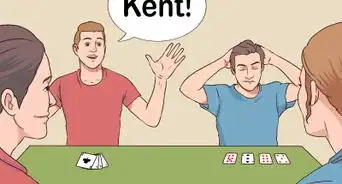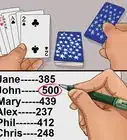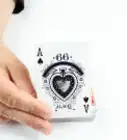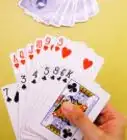This article was co-authored by wikiHow Staff. Our trained team of editors and researchers validate articles for accuracy and comprehensiveness. wikiHow's Content Management Team carefully monitors the work from our editorial staff to ensure that each article is backed by trusted research and meets our high quality standards.
There are 8 references cited in this article, which can be found at the bottom of the page.
wikiHow marks an article as reader-approved once it receives enough positive feedback. In this case, 89% of readers who voted found the article helpful, earning it our reader-approved status.
This article has been viewed 1,529,068 times.
Learn more...
Gin rummy is a two-person card game in which you try to get all of your cards into matching sets or runs before your opponent does. The game is a variation of "Rummy," but instead of laying your cards out during the game for your opponent to see, you hide them until the game ends. To play gin rummy, learn how to deal the cards, form sets and runs, and score points.
Steps
Dealing the Cards
-
1Play with two people. Gin rummy is best played with only two players. But if you have a third person who wants to play, have one person act as the dealer without dealing themselves any cards. Then rotate this position around the table for each subsequent hand.[1]
- For four players, play two separate games. Or form teams, and after the two simultaneous games, add up your and your teammate's scores to see if together you beat your opponents' total.
-
2Use a 52-card deck. If your deck of cards came with any Jokers, place those to the side and don't use them. Note that aces will be low in this game (i.e. worth one point), and jacks, queens, and kings are high (each worth ten points).[2]Advertisement
-
3Draw a card to determine the dealer. Each player should draw a card, face-down from the top of the deck. The person with the lower valued card becomes the dealer. In subsequent rounds, the loser of the previous round will be the dealer.[3]
-
4Deal ten cards to each player. The dealer should distribute ten cards, face-down on the table, to each player. Cards should always be dealt clockwise around the table, but with only two players, you'll just alternate back and forth until you both have ten cards.
-
5Start the stock pile and the discard pile. The remaining cards left after dealing should be placed in a pile face-down on the table. This is the stock pile, and from the top of it the dealer should draw one card and place it face-up next to the stock pile. The face-up card forms the beginning of the discard pile.[4]
Playing the Game
-
1Sort your cards into melds. Look at the ten cards in your hand. Sort them into any possible “melds,” which are sets or runs. A set is three or four cards of the same rank (5-5-5), and a run is three or more cards of consecutive rank in the same suit (4-5-6).[5]
- An example of a set is 10 of diamonds, 10 of spades, and 10 of clubs.
- An example of a run is jack of diamonds, queen of diamonds, and king of diamonds.
- Since aces are low, they can't be in a run with a king. You can have ace-2-3, but not queen-king-ace.
-
2Choose whether to take the card in the discard pile. If you weren't the dealer, you get to decide if you want to pick up the face-up card in the discard pile, or if you want to pass on it because it's not a helpful card for you. If you pass, the dealer can choose to pick it up.[6]
- If you both decline it, the non-dealer picks up the card from the top of the stock pile.
-
3Pick up a new card. Whether you go for the card in the discard pile or the one on top of the stock pile, pick up your new card and assess whether it will help you form any melds. Look to see if you already have a couple of cards with the same numerical value, or if it suddenly connects a couple cards to form a run.[7]
- If you're picking up a card from the stock pile, don't let your opponent see what it is unless you're immediately placing it into the discard pile.
-
4Discard a card you don't want. Select a card from your hand that probably won't be helpful and place it face-up in the discard pile. If a card seems like an outlier that won't match easily with your other cards, then it might be worth discarding. You can also discard whatever you just picked up from the stock pile.
- You can't discard a card you just picked up from the discard pile in that turn. You can discard it during your next turn if you want, but you must keep it for at least one turn.[8]
- At the end of every turn you should still have ten cards.
-
5Take turns picking up cards and discarding cards. Go back and forth drawing cards with your opponent and attempting to form melds with all your cards. At each turn, decide if you want the card that your opponent just placed face-up in the discard pile, or if you want to take the mystery card from the top of the stock pile.
- As you form melds, do not place them on the table. You don't want your opponent to see your progress.[9]
-
6End the game if only two stock cards remain. If a player takes the third to last card in the stock pile and the game is still going, then the hand is cancelled. No points are awarded to either player, and the cards must be re-dealt.[10]
Knocking and Scoring Points
-
1Knock if all your cards form melds. Knocking is how you end gameplay. If you reach a point when all of your cards are part of a meld and none of them are unmatched (these cards are called “deadwood”), then you've reached “gin.” Draw a card once it's your turn and place it face-down on the discard pile to signify that you're knocking.
- Reaching gin earns you 25 bonus points in addition to all your opponent's deadwood points.
- You can physically knock on the table if you want to, but the face-down discard is generally accepted as the knocking symbol.[11]
-
2Knock to prevent your opponent from reaching gin. If you think your opponent may reach gin before you, you can knock early to prevent them from getting those bonus points. Draw a card and discard one when it's your turn, placing the one you don't want face-down on the discard pile to end the game.[12]
-
3End the game only if your deadwood totals ten points or less. You can only knock if the points values for your deadwood cards total ten or less. Kings, queens, and jacks are worth 10, aces are worth 1, and all numerical cards are worth their numerical value.[13]
- For example, if you have a run of 3-4-5-6, a set of 9-9-9-9, and an ace and a king, you can't knock because your deadwood totals 11 points.
-
4Expose your melds to your opponent. Lay down all your cards face-up and divide them into melds on the table. Make it clear for your opponent to see your sets and runs by grouping cards within a meld closely together and also putting some space between the melds themselves.[14]
-
5Lay off deadwood cards onto the knocker's melds. Your opponent now has the chance to lay off their deadwood cards onto your cards to add to melds. For example, if you have three 5's, and one of their deadwood cards is a 5, they can add that to your set. Or they could add that 5 to a run of 6-7-8 or 2-3-4.[15]
- Deadwood can not be laid off onto other deadwood. If you have two 3's that are deadwood, and your opponent has an extra 3, they can not create a new meld.[16]
-
6Lay off cards only if gin has not been reached. If either you or your opponent reaches “gin” and knocks, there's no laying off. This means that one player will potentially end up with a lot of deadwood, and thus a lot of deadwood points for the knocker to claim.
-
7Subtract your deadwood points from your opponent's. Both players should now ignore any melds that have been formed – they don't contribute any points to the scoring. Add up each player's deadwood points and subtract to find the difference. Write down each player's points on a piece of paper.[17]
- For example, after laying off, your opponent might have two Queens left, which totals 20 points. If you have two 2's, that's 4 points. The difference between the two is 16 points.
- If you reached gin, there's no subtraction needed. All of your opponent's deadwood points become yours (plus the 25-point bonus).
-
8Award the non-knocker for an undercut. If you were the knocker, and it turns out your opponent has fewer deadwood points than you, this is called an undercut. The difference between the deadwood points is awarded to them rather than you in this case, along with a 25-point undercut bonus.[18]
- For example, if you knock and have 9 points of deadwood, and your opponent lays off their cards and ends up with 2 points of deadwood, then they've undercut you. They're awarded the 7-point difference, plus 25 bonus points, for a total of 32 points.
-
9Play until someone reaches 100 points. Deal the cards again and continue to play rounds until one player has reached 100 points. This player is awarded 100 bonus points for doing so. Each player then earns an additional 25 points for every round they won.[19]
- If one player doesn't win any rounds, this is a shutout, and the winner earns an additional 100 bonus points.
- The player with the most points after all the tallying is the winner.
Using Strategies to Win
-
1Memorize cards that are being discarded. Keep track of what cards both you and your opponent have discarded, as these will indicate what to avoid collecting. For example, if you saw two kings end up in the discard pile, then you shouldn't hold onto any kings in your hand since these will certainly become deadwood.[20]
-
2Memorize which cards your opponent is picking up. Get a sense for which cards your opponent is picking up from the discard pile since these will clue you into their sets and runs. If you see them picking up a couple 9's, don't discard a 9 you have in your hand or you risk helping them out.[21]
-
3Aim for runs over sets. Runs can be added onto at either end of the sequence. But once you reach three of a kind, sets can only be added onto in one way. And you're less likely to find that one extra card for a set than the two possible cards that can add to your run.[22]
-
4Knock as early as possible. You can't knock until your deadwood is down to 10 or fewer points, but as soon as you reach that threshold, it might be a good idea to knock. Waiting too long in the hopes that you'll reach gin could mean letting your opponent reach it first.[23]
Community Q&A
-
QuestionHow can I play against a friend?
 Community AnswerAsk a friend if they would like to play with you, and then show them the rules to the game.
Community AnswerAsk a friend if they would like to play with you, and then show them the rules to the game. -
QuestionIf a player knocks with 3 points unmelded and the opponent has 3 also, how is the hand scored?
 Community AnswerWhen the knocker and the opponent have equal value of unmelded cards (termed "deadwood"), this is an undercut. The knocker's opponent scores 10 points. Note that there are variations in scoring.
Community AnswerWhen the knocker and the opponent have equal value of unmelded cards (termed "deadwood"), this is an undercut. The knocker's opponent scores 10 points. Note that there are variations in scoring. -
QuestionCan a player go inside the pile and pick up a card they can form a meld with out of turn by declaring "Rummy on the table"?
 Community AnswerNo, players can only take a card when it is their turn to play, and can only take a card from either the stock pile or the top of the discard pile.
Community AnswerNo, players can only take a card when it is their turn to play, and can only take a card from either the stock pile or the top of the discard pile.
References
- ↑ http://www.rummy-games.com/rules/gin-rummy-for-three.html
- ↑ https://www.pagat.com/rummy/ginrummy.html
- ↑ https://www.pagat.com/rummy/ginrummy.html
- ↑ http://www.grandparents.com/grandkids/activities-games-and-crafts/gin-rummy
- ↑ http://www.rummy-games.com/rules/gin-rummy.html
- ↑ https://www.pagat.com/rummy/ginrummy.html
- ↑ http://www.rummy-games.com/rules/gin-rummy.html
- ↑ https://www.pagat.com/rummy/ginrummy.html
- ↑ http://www.grandparents.com/grandkids/activities-games-and-crafts/gin-rummy
- ↑ https://www.pagat.com/rummy/ginrummy.html
- ↑ http://cardgameheaven.com/gin-rummy/
- ↑ http://www.rummy-games.com/rules/gin-rummy.html
- ↑ https://www.pagat.com/rummy/ginrummy.html
- ↑ http://www.rummy-games.com/rules/gin-rummy.html
- ↑ https://www.pagat.com/rummy/ginrummy.html
- ↑ https://www.pagat.com/rummy/ginrummy.html
- ↑ https://www.pagat.com/rummy/ginrummy.html
- ↑ http://www.rummy-games.com/rules/gin-rummy.html
- ↑ http://www.rummy-games.com/rules/gin-rummy.html
- ↑ https://www.youtube.com/watch?v=TY5P7JUXaGg&feature=youtu.be&t=6
- ↑ https://www.youtube.com/watch?v=TY5P7JUXaGg&feature=youtu.be&t=34
- ↑ https://www.gamecolony.com/gin_rummy_game_strategy.shtml
- ↑ https://www.gamecolony.com/gin_rummy_game_strategy.shtml
About This Article
To play Gin Rummy, try to score more points than your opponent by making combinations of 3 or more cards in your hand. Gin Rummy is usually played over several rounds until one player gets more than 100 points and wins the game. To get started, choose either you or your opponent to be the dealer, and deal out 10 cards to each of you. Place the rest of the deck face-down in the center of the playing area, and flip the top card face-up next to it. The player who didn’t deal goes first. On your turn, you can either take the top card on the face-up pile or the top card on the face-down pile. After you take a card, discard a different card from your hand in the face-up pile. Then it’s your opponent’s turn. Play continues back and forth like this. As you draw and discard cards, try to make combinations of 3 or more cards that are the same rank or that make a run in the same suit, which are called melds. Having melds in your hand will get you points at the end of the round. For a round to end, one player must go out, which can happen in one of two ways. First, they can knock. Knocking is when a player chooses to end the round. A player can only knock if the unmatched cards in their hand add up to 10 or less. Ace through 10 are worth their face value, and jacks, queens, and kings are worth 10 points. When a player knocks, both players reveal their cards, and the player who didn’t knock can play any of their unmatched cards off of the knocking player’s melds if possible. Then, the knocking player subtracts the total of their unmatched cards from the total of their opponent’s unmatched cards and adds that number to their score. If the total of their opponent’s unmatched cards is less than the total of their unmatched cards, the difference goes to their opponent instead, and their opponent gets a 25-point bonus. The second way a round can end is if a player goes gin. To go gin, every card in your hand must be part of a meld. When a player goes gin, they get a 25-point bonus, plus the total of all of their opponent’s unmatched cards. Once a round ends, add up each of your scores, then have the player who didn’t deal last time deal a new round. Keep playing until one of you scores over 100 points! If you want to learn more, such as strategies to win or how to score points, keep reading!






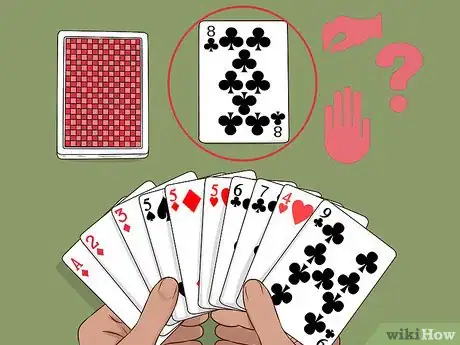
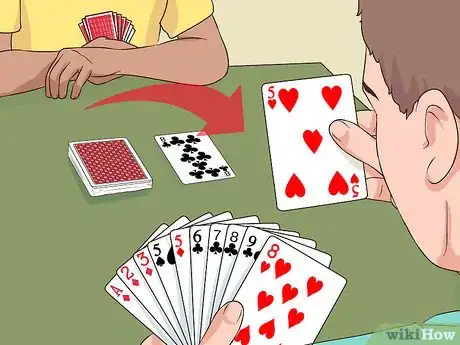
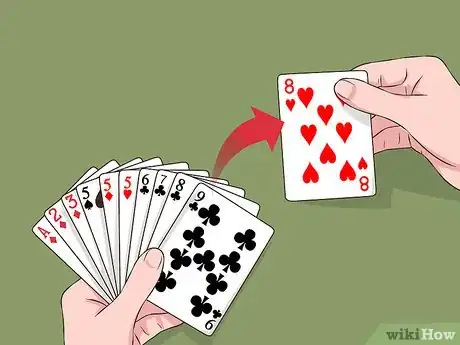
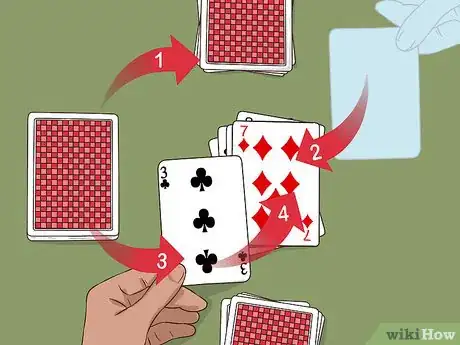


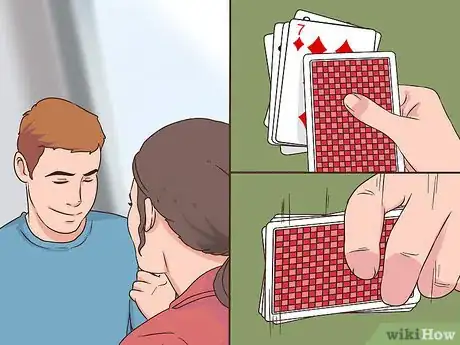






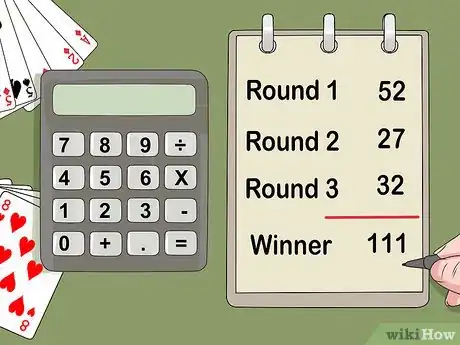
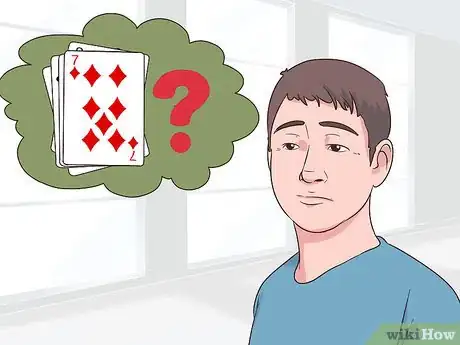

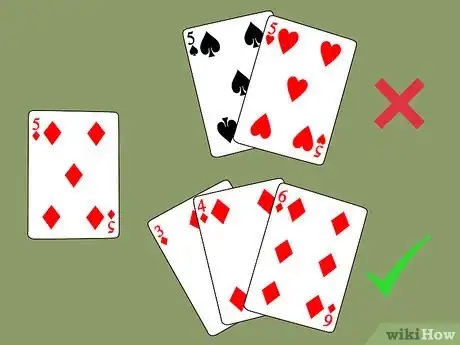
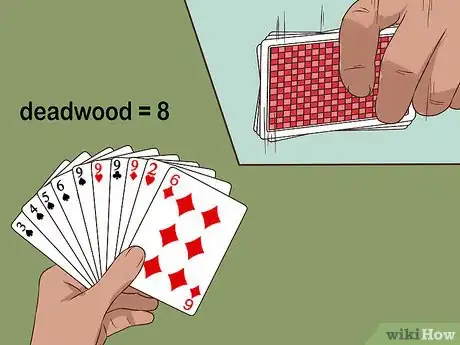
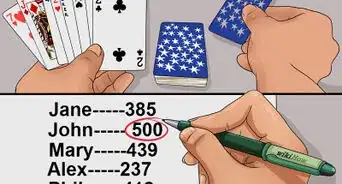
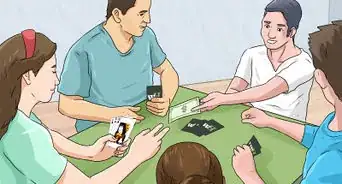

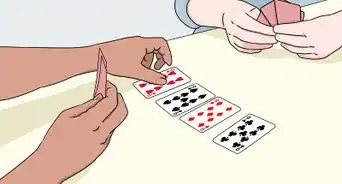

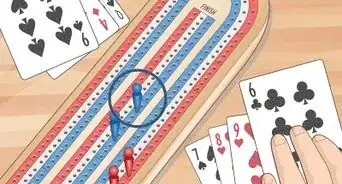
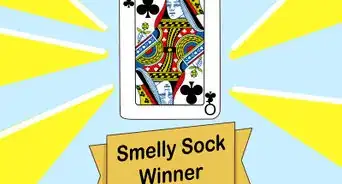
-Step-7-Version-3.webp)


